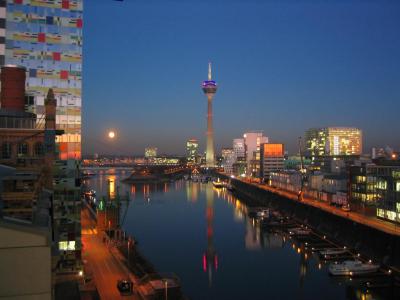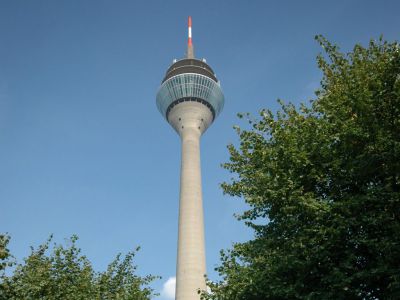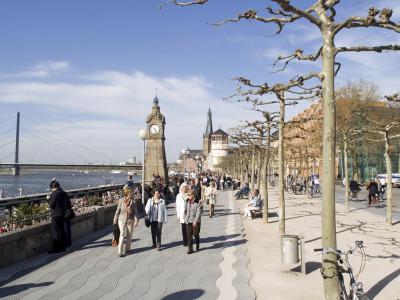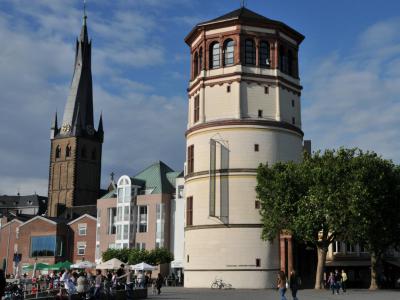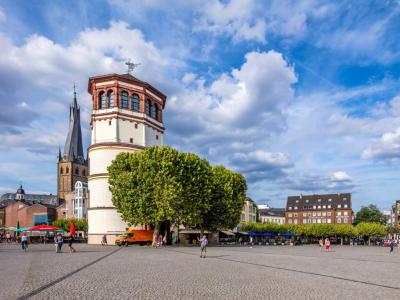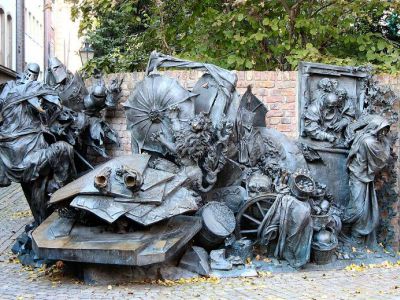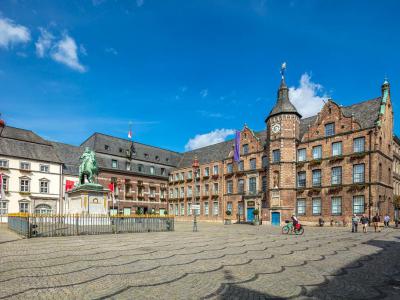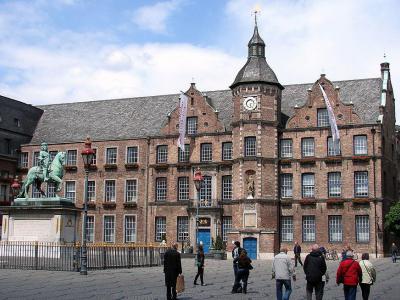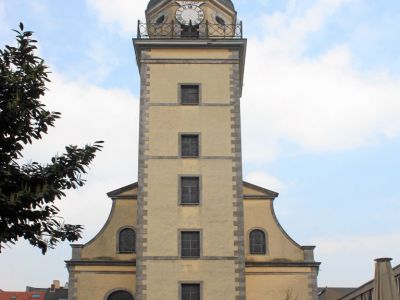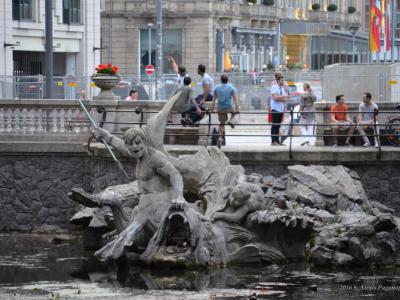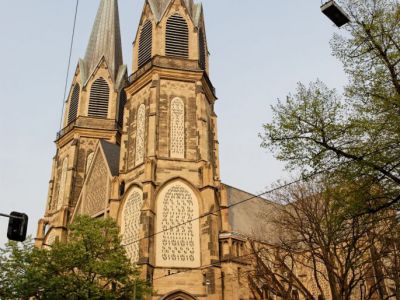Custom Walk in Dusseldorf, Germany by alisongrmail_d87fe created on 2025-03-12
Guide Location: Germany » Dusseldorf
Guide Type: Custom Walk
# of Sights: 12
Tour Duration: 2 Hour(s)
Travel Distance: 4 Km or 2.5 Miles
Share Key: QTQUR
Guide Type: Custom Walk
# of Sights: 12
Tour Duration: 2 Hour(s)
Travel Distance: 4 Km or 2.5 Miles
Share Key: QTQUR
How It Works
Please retrieve this walk in the GPSmyCity app. Once done, the app will guide you from one tour stop to the next as if you had a personal tour guide. If you created the walk on this website or come to the page via a link, please follow the instructions below to retrieve the walk in the app.
Retrieve This Walk in App
Step 1. Download the app "GPSmyCity: Walks in 1K+ Cities" on Apple App Store or Google Play Store.
Step 2. In the GPSmyCity app, download(or launch) the guide "Dusseldorf Map and Walking Tours".
Step 3. Tap the menu button located at upper right corner of the "Walks" screen and select "Retrieve custom walk". Enter the share key: QTQUR
1) MedienHafen (Media Harbour) (must see)
MedienHafen, or the Media Harbour in English, sits on the banks of the Rhine River. The renovation of the old harbor, which was previously occupied by warehouses and abandoned buildings, led to a lively, exciting and modern area. Media Harbour is frequented by locals as well as tourists who want to see the best of Duesseldorf's art and culture.
The harbor's renovation began in the 1990s. Arguably the most spectacular view in the harbor is that of New Zollhof. Also known as the Gehry Buildings, New Zollhof stands out on the shoreline. Likewise, the Rheinturm (Rhine Tower) is located in Media Harbour. This tallest building in the city has an excellent restaurant and an observation deck.
Another prominent landmark in the Media Harbour is the Energie-Pyramide. The public artwork was crafted by sculptors Thomas Schonauer and Berend F. van Laar in 1988. It is made of stainless, igneous rock and basalt lava.
Most of the buildings in the Media Harbour are contemporary offices and media firms. There are also a number of shopping areas with fashion brands as well as restaurants, bars and a theatre. Many of these buildings are designed by internationally lauded architects, which creates an interesting mix of the old world with modern sights.
A walk along Media Harbour might include a stop at the scenic vista of Brucke am Medianhafen, or Media Harbour Bridge. Tourists may use this bridge to reach the Paradiesstrand Düsseldorf Hafen, a wildlife refuge that has a beach and a swimming area. Those who would rather focus on art and culture could try the Kunstgiesserei Kayser art center or the Arthena Foundation art gallery.
The harbor's renovation began in the 1990s. Arguably the most spectacular view in the harbor is that of New Zollhof. Also known as the Gehry Buildings, New Zollhof stands out on the shoreline. Likewise, the Rheinturm (Rhine Tower) is located in Media Harbour. This tallest building in the city has an excellent restaurant and an observation deck.
Another prominent landmark in the Media Harbour is the Energie-Pyramide. The public artwork was crafted by sculptors Thomas Schonauer and Berend F. van Laar in 1988. It is made of stainless, igneous rock and basalt lava.
Most of the buildings in the Media Harbour are contemporary offices and media firms. There are also a number of shopping areas with fashion brands as well as restaurants, bars and a theatre. Many of these buildings are designed by internationally lauded architects, which creates an interesting mix of the old world with modern sights.
A walk along Media Harbour might include a stop at the scenic vista of Brucke am Medianhafen, or Media Harbour Bridge. Tourists may use this bridge to reach the Paradiesstrand Düsseldorf Hafen, a wildlife refuge that has a beach and a swimming area. Those who would rather focus on art and culture could try the Kunstgiesserei Kayser art center or the Arthena Foundation art gallery.
2) Rheinturm (Rhine Tower) (must see)
The Rheinturm, or Rhine Tower, is a 789-foot tall telecommunications tower. It carries broadcasts for radio and television but is best known for being the tallest building in the city. Along with its functional properties, the Rhine Tower is home to an observation deck and a revolving restaurant.
Construction on the tower began in 1979 and was completed in 1981. Largely made of reinforced concrete, the Rhine Tower weighs an impressive 22,500 tons. It was designed by architect Harald Deilmann, who is best known for his work on university buildings, theatres, hospitals and office buildings.
A sculptural clock on the Rhine Tower's shaft called Lichtzeitpegel, or Light Time Level, was designed by Horst H. Baumann. The number of dots represents the hour, minutes and seconds. It is the largest digital clock in the world.
The observation deck is open to the public daily from 10 am to midnight. The restaurant within the Rhine Tower, QOMO, is open from 6 pm to midnight.
Construction on the tower began in 1979 and was completed in 1981. Largely made of reinforced concrete, the Rhine Tower weighs an impressive 22,500 tons. It was designed by architect Harald Deilmann, who is best known for his work on university buildings, theatres, hospitals and office buildings.
A sculptural clock on the Rhine Tower's shaft called Lichtzeitpegel, or Light Time Level, was designed by Horst H. Baumann. The number of dots represents the hour, minutes and seconds. It is the largest digital clock in the world.
The observation deck is open to the public daily from 10 am to midnight. The restaurant within the Rhine Tower, QOMO, is open from 6 pm to midnight.
3) Rheinuferpromenade (Rhine Embankment Promenade) (must see)
The Rhine Embankment Promenade was designed by Architect Niklaus Fritschi and built between 1990 and 1997. This riverside promenade is popular with residents and visitors alike and is considered the Rhine's most attractive promenade. Visitors can enjoy the river views and breezes or stop for a cafe beverage or treat.
The promenade was originally built around 1900 and featured two levels. The lower level was used by shipping traffic, and the upper level was used as a promenade. The Rhine River's bank was redesigned after World War II, and a multi-lane street was constructed.
Road traffic used to run parallel to the river, but the Rhine bank tunnel was completed in the 1990s. This new infrastructure means that traffic runs underground. Pedestrians can now enjoy walking or biking along the promenade without road traffic. One million visitors celebrated the promenade's opening in 1995.
There are many historic and landmark buildings on the promenade. In addition, visitors can access the Dusseldorf Art Academy, the maritime museum, the state parliament, and the Apollo Variete.
The promenade hosts several Rhine boat tour operators, where you can enjoy seeing the city from another perspective. The promenade's staircase is a popular spot for people-watching and sunbathing.
The promenade hosts almost 300 cafes, bars, restaurants, and discos. Most of these venues are connected, so you can hop along the row and enjoy non-stop entertainment and fun. Promenade bars serve Dussedorf’s favorite brew, the Altbier. Be sure to order one to get a true taste of Dusseldorf.
The promenade hosts festivals and events throughout the year. For example, visitors might catch an exhibition, open-air movie screening, or festive market.
The promenade is a fantastic place to watch the sunset from. The city's lights start to come on and are beautifully reflected in the water.
The promenade was originally built around 1900 and featured two levels. The lower level was used by shipping traffic, and the upper level was used as a promenade. The Rhine River's bank was redesigned after World War II, and a multi-lane street was constructed.
Road traffic used to run parallel to the river, but the Rhine bank tunnel was completed in the 1990s. This new infrastructure means that traffic runs underground. Pedestrians can now enjoy walking or biking along the promenade without road traffic. One million visitors celebrated the promenade's opening in 1995.
There are many historic and landmark buildings on the promenade. In addition, visitors can access the Dusseldorf Art Academy, the maritime museum, the state parliament, and the Apollo Variete.
The promenade hosts several Rhine boat tour operators, where you can enjoy seeing the city from another perspective. The promenade's staircase is a popular spot for people-watching and sunbathing.
The promenade hosts almost 300 cafes, bars, restaurants, and discos. Most of these venues are connected, so you can hop along the row and enjoy non-stop entertainment and fun. Promenade bars serve Dussedorf’s favorite brew, the Altbier. Be sure to order one to get a true taste of Dusseldorf.
The promenade hosts festivals and events throughout the year. For example, visitors might catch an exhibition, open-air movie screening, or festive market.
The promenade is a fantastic place to watch the sunset from. The city's lights start to come on and are beautifully reflected in the water.
4) Schlossturm (Castle Tower)
The Castle Tower is the only remaining portion of the Dusseldorf Castle. Dusseldorf Castle was originally built in 1260, and the tower's first three levels date to the 13th century.
Alessandro Pasqualini added the fourth level in 1552, which features a polygonal design with Tuscan columns. In 1845, King Friedrich Wilhelm IV commissioned architect Friedrich August Stuler to design the fifth level with a round arch style. In 1882, a tent roof was added.
Over the centuries, Dusseldorf Castle fell into disrepair and was mostly destroyed by a fire in 1872. The tower's wind vane represents a fire blower designed to commemorate the castle fire.
The Castle Tower now hosts the Rhine Maritime Museum, which focuses on Dusseldorf's water transport history. The exhibits feature ship replicas and interactive displays. In addition, visitors can get an excellent view of current Rhine river ships from the museum's top floor.
Alessandro Pasqualini added the fourth level in 1552, which features a polygonal design with Tuscan columns. In 1845, King Friedrich Wilhelm IV commissioned architect Friedrich August Stuler to design the fifth level with a round arch style. In 1882, a tent roof was added.
Over the centuries, Dusseldorf Castle fell into disrepair and was mostly destroyed by a fire in 1872. The tower's wind vane represents a fire blower designed to commemorate the castle fire.
The Castle Tower now hosts the Rhine Maritime Museum, which focuses on Dusseldorf's water transport history. The exhibits feature ship replicas and interactive displays. In addition, visitors can get an excellent view of current Rhine river ships from the museum's top floor.
5) Burgplatz (Castle Square) (must see)
Castle Square is located on the Rhine River, near the location of the original town. This open space was named after Dusseldorf Castle, which was originally built during the 14th century. The castle was built to collect tolls, hence its location right on the river. Dusseldorf Castle was mostly torn down in 1892, and the remaining castle tower houses a museum.
Dusseldorf Castle and Castle Square were the city's center for centuries. When the castle deteriorated and was removed, Castle Square became a bigger, more open area. The area changed again when a busy highway was built here after World War II.
Finally, the area was redesigned in 1995 when the Rhine Embankment Promenade was built. Visitors can take a flight of steps to reach the Rhine's banks from Castle Square. The square often hosts different festivals and events and the open space offers visitors and residents a convenient meeting place.
The northern part of Castle Square faces the Rhine and the castle tower. The square is paved with cobblestones, which adds to its charm. The Radschlager fountain was added in 1954 and features a depiction of two cartwheeling boys.
Castle Square features the popular Wheel of Vision Ferris Wheel. This is a popular attraction day and night and offers a relaxing way to get the best views of historic Dusseldorf.
Dusseldorf Castle and Castle Square were the city's center for centuries. When the castle deteriorated and was removed, Castle Square became a bigger, more open area. The area changed again when a busy highway was built here after World War II.
Finally, the area was redesigned in 1995 when the Rhine Embankment Promenade was built. Visitors can take a flight of steps to reach the Rhine's banks from Castle Square. The square often hosts different festivals and events and the open space offers visitors and residents a convenient meeting place.
The northern part of Castle Square faces the Rhine and the castle tower. The square is paved with cobblestones, which adds to its charm. The Radschlager fountain was added in 1954 and features a depiction of two cartwheeling boys.
Castle Square features the popular Wheel of Vision Ferris Wheel. This is a popular attraction day and night and offers a relaxing way to get the best views of historic Dusseldorf.
6) Stadterhebungs Monument (City Founding Monument)
The City Founding Monument was created in 1988 to celebrate Dusseldorf's 700th anniversary. Bert Gerresheim crafted the bronze monument that depicts important scenes from Dusseldorf's history. The monument shows the Battle of Worringen, the city's original deed, and celebrates Saint Lambertus church.
The Battle of Worringen was fought on the 5th of June 1288 near the town of Worringen, which is now the northernmost borough of Cologne. Dusseldorf and Cologne residents fought against the Archbishop of Cologne's army during this battle. It was one of the largest battles in Europe in the Middle Ages and over 1100 people died during the battle. The Archbishop of Cologne was defeated.
After the battle, Count Adolf von Berg granted the Dusseldorf city charter. Cologne gained its independence from the Archbishopric after this decisive battle and finally became a free imperial city in 1475.
The monument's helmets and breastplates represent the famous 1288 battle. The cart represents Dusseldorf's market rights. The monument also shows the original town survey.
The bronze monument is very detailed and has many artistic layers. Visitors can gain an appreciation of the city's long history and storied birth.
The Battle of Worringen was fought on the 5th of June 1288 near the town of Worringen, which is now the northernmost borough of Cologne. Dusseldorf and Cologne residents fought against the Archbishop of Cologne's army during this battle. It was one of the largest battles in Europe in the Middle Ages and over 1100 people died during the battle. The Archbishop of Cologne was defeated.
After the battle, Count Adolf von Berg granted the Dusseldorf city charter. Cologne gained its independence from the Archbishopric after this decisive battle and finally became a free imperial city in 1475.
The monument's helmets and breastplates represent the famous 1288 battle. The cart represents Dusseldorf's market rights. The monument also shows the original town survey.
The bronze monument is very detailed and has many artistic layers. Visitors can gain an appreciation of the city's long history and storied birth.
7) Marktplatz (Market Square)
Market Square was first mentioned in historical records in 1392. Since then, Market Square has hosted a market in addition to many historical events and public announcements. The square is dominated by the Old Town Hall and the iconic Jan Wellem monument.
Markets have been hosted in the square since 1482. In the early 1500s, a follower of Martin Luther preached in an inn on the square. The town hall moved to Market Square in the late 1500s. The square was also home to the Old Theater, which was built in 1739 but destroyed during World War II.
Market Square hosts a Saturday market where visitors can shop for produce, German sausages, cheese, flowers, and prepared food. In addition, Market Square hosts wine festivals, art and crafts events, and a Christmas Market.
Carnival begins on November 11th outside the Town Hall, and the parade moves through Market Square.
Markets have been hosted in the square since 1482. In the early 1500s, a follower of Martin Luther preached in an inn on the square. The town hall moved to Market Square in the late 1500s. The square was also home to the Old Theater, which was built in 1739 but destroyed during World War II.
Market Square hosts a Saturday market where visitors can shop for produce, German sausages, cheese, flowers, and prepared food. In addition, Market Square hosts wine festivals, art and crafts events, and a Christmas Market.
Carnival begins on November 11th outside the Town Hall, and the parade moves through Market Square.
8) Rathaus (Old Town Hall)
Old Town Hall was built in 1573 and has hosted the city council and municipal administration ever since. Old Town Hall also hosted the estates of the Duchies of Julich-Berg until 1806.
Old Town Hall was built in the Renaissance style. It features two curved gables and a five-level, eight-sided stair tower.
Johann Joseph Couven renovated Old Town Hall in 1749. Couven added pilasters to the tower and added cornices between each level. In addition, Couven added a new portal with a balcony.
The current building features five wings. It is located at Market Square 1. In addition, other wings include the New Town Hall and the 1706 Grupello House.
After World War II, Old Town Hall's facades were restored. Visitors can find the city's coat of arms and an inscription in the stair tower.
Old Town Hall was built in the Renaissance style. It features two curved gables and a five-level, eight-sided stair tower.
Johann Joseph Couven renovated Old Town Hall in 1749. Couven added pilasters to the tower and added cornices between each level. In addition, Couven added a new portal with a balcony.
The current building features five wings. It is located at Market Square 1. In addition, other wings include the New Town Hall and the 1706 Grupello House.
After World War II, Old Town Hall's facades were restored. Visitors can find the city's coat of arms and an inscription in the stair tower.
9) Altstadt (Old Town)
Dusseldorf’s Old Town (Altstadt) might be compact at just 0.48 square kilometers, but it packs a vibrant punch as the city’s social and cultural heart. Known endearingly as “the longest bar in the world,” Altstadt’s bustling streets house over 300 bars, pubs, and discothèques, with each bar counter practically blending into the next. It’s the place to try Dusseldorf’s famous Altbier, a locally brewed beer rooted in tradition since the late 19th century.
Wandering through Old Town’s lively network of lanes, visitors encounter landmarks like the Saint Lambertus Basilica with its signature twisted spire, the historic Rathaus (City Hall), and the grand Jan Wellem equestrian statue at Burgplatz. The area also caters to art enthusiasts with galleries such as the Art Collection NRW, home to Klee and Dalí masterpieces, and the Maritime Museum (Schifffahrtsmuseum), dedicated to the region’s shipping history.
Old Town’s culinary scene stretches beyond traditional Rhineland specialties to encompass international flavors from Italian to sushi. Shoppers can lose themselves on Flingerstrasse and Mittelstrasse, or take a breather on the scenic Rhine promenade, with views of the Rhine and Oberkassel across the river. For a touch of whimsy, Wibbel the Tailor’s statue awaits, rumored to bring luck to those who touch it. Whether you end the day with a fine drink overlooking the Rhine or dancing in one of its energetic clubs, Dusseldorf’s Old Town is as enchanting as it is unforgettable.
Wandering through Old Town’s lively network of lanes, visitors encounter landmarks like the Saint Lambertus Basilica with its signature twisted spire, the historic Rathaus (City Hall), and the grand Jan Wellem equestrian statue at Burgplatz. The area also caters to art enthusiasts with galleries such as the Art Collection NRW, home to Klee and Dalí masterpieces, and the Maritime Museum (Schifffahrtsmuseum), dedicated to the region’s shipping history.
Old Town’s culinary scene stretches beyond traditional Rhineland specialties to encompass international flavors from Italian to sushi. Shoppers can lose themselves on Flingerstrasse and Mittelstrasse, or take a breather on the scenic Rhine promenade, with views of the Rhine and Oberkassel across the river. For a touch of whimsy, Wibbel the Tailor’s statue awaits, rumored to bring luck to those who touch it. Whether you end the day with a fine drink overlooking the Rhine or dancing in one of its energetic clubs, Dusseldorf’s Old Town is as enchanting as it is unforgettable.
10) Neanderkirche (Neander Church)
The Neander Church is the oldest Protestant church in Dusseldorf, standing in the heart of the city’s historic Altstadt. This early Baroque structure, completed in 1687, originally served as the city’s first Reformist church and marked a significant moment for Protestant worship in Dusseldorf following a long period of restricted religious freedoms. Although it was initially designed to remain unobtrusive due to public opposition, the Neanderkirche has grown into a prominent landmark, now seating around 500 attendees.
Named in 1916 after the 17th-century hymn writer and Reformed minister Joachim Neander, the church remains a key site for Protestant worship under the Evangelical Parish of Dusseldorf-Mitte. The interior’s renowned acoustics make it a beloved venue for chamber music and a long-standing series of summer organ concerts, featuring the Rieger organ installed in 1965. This organ, designed by Gerhard Schwarz and Hubert Meyers, attracts both local and international musicians, adding to the church's reputation as a cultural hub. The church’s choir, initially founded by musician Oskar Gottlieb Blarr and continued under various directors, also enriches its musical legacy, making the Neander Church a central part of Dusseldorf’s spiritual and cultural life.
Named in 1916 after the 17th-century hymn writer and Reformed minister Joachim Neander, the church remains a key site for Protestant worship under the Evangelical Parish of Dusseldorf-Mitte. The interior’s renowned acoustics make it a beloved venue for chamber music and a long-standing series of summer organ concerts, featuring the Rieger organ installed in 1965. This organ, designed by Gerhard Schwarz and Hubert Meyers, attracts both local and international musicians, adding to the church's reputation as a cultural hub. The church’s choir, initially founded by musician Oskar Gottlieb Blarr and continued under various directors, also enriches its musical legacy, making the Neander Church a central part of Dusseldorf’s spiritual and cultural life.
11) Tritonenbrunnen (Triton Fountain)
The Triton Fountain (Tritonenbrunnen) is one of Dusseldorf's most captivating landmarks, proudly situated on Konigsallee, the city’s famed luxury boulevard. Designed by the acclaimed German sculptor Friedrich Coubillier, this fountain was inaugurated in 1898 as a commission by Heinrich Lueg, a former Mayor of Dusseldorf. Its purpose was to mark the city’s progress and growing prosperity, particularly through its ties to maritime trade.
Standing at the northern end of Ko-Graben, the fountain is a stunning ensemble of classical and mythological motifs. Its central sculpture features three powerful tritons, the mythical Greek sea messengers, locked in a fierce struggle with a colossal fish. Each triton, crafted in bronze, holds a shell that cascades water into the basin below. They are joined by two cherubs in the struggle, while, to either side, fountains flow into large shell-shaped basins, adding further drama to the scene.
The Triton Fountain’s details reflect a blend of classical artistry and Romantic symbolism, common in the period of its construction. Above the tritons, two sea nymphs rest gracefully on rocks, symbolizing navigation and trade, pillars of Dusseldorf’s historical economy. At the fountain’s pinnacle stands Fortuna, the Roman goddess of fortune, holding a ship’s rudder and a cornucopia-symbols of the wealth and prosperity Dusseldorf has long enjoyed.
A popular spot for photos, the Triton Fountain’s majestic presence makes it a scenic endpoint, on Konigsallee. Visitors can sit by the nearby stone benches and admire the art, atmosphere, and the nearby luxury boutiques and galleries. Today, the fountain endures not only as a testament to Dusseldorf’s artistic and historical legacy but also as a reminder of the city’s longstanding blend of tradition and progress.
Standing at the northern end of Ko-Graben, the fountain is a stunning ensemble of classical and mythological motifs. Its central sculpture features three powerful tritons, the mythical Greek sea messengers, locked in a fierce struggle with a colossal fish. Each triton, crafted in bronze, holds a shell that cascades water into the basin below. They are joined by two cherubs in the struggle, while, to either side, fountains flow into large shell-shaped basins, adding further drama to the scene.
The Triton Fountain’s details reflect a blend of classical artistry and Romantic symbolism, common in the period of its construction. Above the tritons, two sea nymphs rest gracefully on rocks, symbolizing navigation and trade, pillars of Dusseldorf’s historical economy. At the fountain’s pinnacle stands Fortuna, the Roman goddess of fortune, holding a ship’s rudder and a cornucopia-symbols of the wealth and prosperity Dusseldorf has long enjoyed.
A popular spot for photos, the Triton Fountain’s majestic presence makes it a scenic endpoint, on Konigsallee. Visitors can sit by the nearby stone benches and admire the art, atmosphere, and the nearby luxury boutiques and galleries. Today, the fountain endures not only as a testament to Dusseldorf’s artistic and historical legacy but also as a reminder of the city’s longstanding blend of tradition and progress.
12) St. Maria Empfaengnis
The Roman Catholic Church of Saint Maria Empfangnis, also known as Saint Mary's Church, stands in Dusseldorf as a prime example of neo-Gothic architecture with a rich history marked by resilience and faith. Designed by Ludwig Becker, the Mainz cathedral master builder, the church was constructed between 1894 and 1896 to serve the Catholics of the growing Pempelfort area. Located in the city center near Tonhallenstrasse and Oststrasse, its double-tower façade and three-aisled basilica style mirror the grandeur of Rhenish cathedrals. The parish of Saint Maria Empfangnis initially served as an independent entity but merged with the Saint Lambertus parish in 2011, forming a unified community in Dusseldorf under the Archdiocese of Cologne.
As the first fully electrically lit church in Dusseldorf, Saint Mary’s was a marvel in 1896, but it faced severe devastation during World War II. Bombings in 1943 destroyed much of the structure, including its interior and cherished furnishings, like the high altar and Madonna created by Friedrich Wilhelm Mengelberg and sculptor Anton Josef Reiss. The church’s reconstruction spanned decades, with post-war restoration by architect Josef Lehmbrock and further interior refinements by Wilhelm Dahmen in the late 20th century, which restored the design close to Becker's original vision. The church’s distinctive stained glass windows, added in 1962–63 by Gunter Grote, add a vibrant, abstract narrative to the interiors, symbolizing endurance and artistic rebirth.
Today, Saint Mary’s Church serves as a spiritual and community hub. It has housed a Franciscan fraternization community since 2014, following the relocation of monks from the nearby Saint Anthony's monastery. The interior also features a significant organ built by Johannes Klais in 1956, known for its complex mechanical stop action and rich acoustics across 44 stops.
As the first fully electrically lit church in Dusseldorf, Saint Mary’s was a marvel in 1896, but it faced severe devastation during World War II. Bombings in 1943 destroyed much of the structure, including its interior and cherished furnishings, like the high altar and Madonna created by Friedrich Wilhelm Mengelberg and sculptor Anton Josef Reiss. The church’s reconstruction spanned decades, with post-war restoration by architect Josef Lehmbrock and further interior refinements by Wilhelm Dahmen in the late 20th century, which restored the design close to Becker's original vision. The church’s distinctive stained glass windows, added in 1962–63 by Gunter Grote, add a vibrant, abstract narrative to the interiors, symbolizing endurance and artistic rebirth.
Today, Saint Mary’s Church serves as a spiritual and community hub. It has housed a Franciscan fraternization community since 2014, following the relocation of monks from the nearby Saint Anthony's monastery. The interior also features a significant organ built by Johannes Klais in 1956, known for its complex mechanical stop action and rich acoustics across 44 stops.
